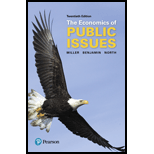
The implications, if the spending exceeds the total revenue, which will be earned from implementation of tax in the future. The change in people’s behavior corresponding to these implications.
Concept introduction:
Budget balance:
The amount by which the government spending differs from the amount of total revenue collected from taxes is referred as budget balance. It is considered to be a deficit, if the expenditure exceeds the revenue collected from tax. It is a surplus, if the revenue exceeds expenditure and it is balanced if both are equal.
Debt: Debt is the borrowed amount that is used to finance the requirements of a company or a person. Terms of the debt are based on the agreement between the two parties where a borrower is bound to return the amount within a fixed time at some interest rates.
Explanation:
- If the government wants to spend more than the revenue it will collected from taxes, then it depends on the borrowing that is debt.
- The debt is to be repaid within a fixed time along with interests. In order to repay the debt, the government has two options. It imposes a higher tax on the public to compensate the excess spending.
- It can also borrow to repay the debt and delay the tax imposition. But this is not a permanent solution, as it would be paid again by increasing the tax rates by a huge amount in the future.
- The people should behave in a way, such that they can maintain their permanent consumption level. The prediction of higher tax will compel them to save more and spend less in the current time, such that the disposable income remains the same in the future.
Explanation of Solution
- If the government wants to spend more than the revenue it will collected from taxes, then it depends on the borrowing that is debt.
- The debt is to be repaid within a fixed time along with interests. In order to repay the debt, the government has two options. It imposes a higher tax on the public to compensate the excess spending.
- It can also borrow to repay the debt and delay the tax imposition. But this is not a permanent solution, as it would be paid again by increasing the tax rates by a huge amount in the future.
- The people should behave in a way, such that they can maintain their permanent consumption level. The prediction of higher tax will compel them to save more and spend less in the current time, such that the disposable income remains the same in the future.
Concept introduction:
Budget balance:
The amount by which the government spending differs from the amount of total revenue collected from taxes is referred as budget balance. It is considered to be a deficit, if the expenditure exceeds the revenue collected from tax. It is a surplus, if the revenue exceeds expenditure and it is balanced if both are equal.
Debt: Debt is the borrowed amount that is used to finance the requirements of a company or a person. Terms of the debt are based on the agreement between the two parties where a borrower is bound to return the amount within a fixed time at some interest rates.
Want to see more full solutions like this?
Chapter 14 Solutions
Pearson eText for Economics of Public Issues -- Instant Access (Pearson+)
- Critically analyse the five (5) characteristics of Ubuntu and provide examples of how they apply to the National Health Insurance (NHI) in South Africa.arrow_forwardCritically analyse the five (5) characteristics of Ubuntu and provide examples of how they apply to the National Health Insurance (NHI) in South Africa.arrow_forwardOutline the nine (9) consumer rights as specified in the Consumer Rights Act in South Africa.arrow_forward
- In what ways could you show the attractiveness of Philippines in the form of videos/campaigns to foreign investors? Cite 10 examples.arrow_forwardExplain the following terms and provide an example for each term: • Corruption • Fraud • Briberyarrow_forwardIn what ways could you show the attractiveness of a country in the form of videos/campaigns?arrow_forward

 Principles of Economics (12th Edition)EconomicsISBN:9780134078779Author:Karl E. Case, Ray C. Fair, Sharon E. OsterPublisher:PEARSON
Principles of Economics (12th Edition)EconomicsISBN:9780134078779Author:Karl E. Case, Ray C. Fair, Sharon E. OsterPublisher:PEARSON Engineering Economy (17th Edition)EconomicsISBN:9780134870069Author:William G. Sullivan, Elin M. Wicks, C. Patrick KoellingPublisher:PEARSON
Engineering Economy (17th Edition)EconomicsISBN:9780134870069Author:William G. Sullivan, Elin M. Wicks, C. Patrick KoellingPublisher:PEARSON Principles of Economics (MindTap Course List)EconomicsISBN:9781305585126Author:N. Gregory MankiwPublisher:Cengage Learning
Principles of Economics (MindTap Course List)EconomicsISBN:9781305585126Author:N. Gregory MankiwPublisher:Cengage Learning Managerial Economics: A Problem Solving ApproachEconomicsISBN:9781337106665Author:Luke M. Froeb, Brian T. McCann, Michael R. Ward, Mike ShorPublisher:Cengage Learning
Managerial Economics: A Problem Solving ApproachEconomicsISBN:9781337106665Author:Luke M. Froeb, Brian T. McCann, Michael R. Ward, Mike ShorPublisher:Cengage Learning Managerial Economics & Business Strategy (Mcgraw-...EconomicsISBN:9781259290619Author:Michael Baye, Jeff PrincePublisher:McGraw-Hill Education
Managerial Economics & Business Strategy (Mcgraw-...EconomicsISBN:9781259290619Author:Michael Baye, Jeff PrincePublisher:McGraw-Hill Education





